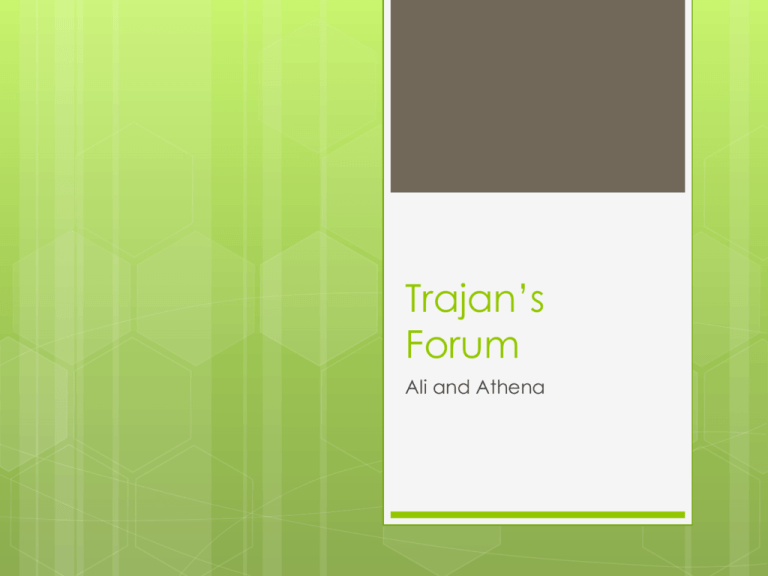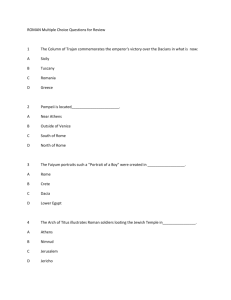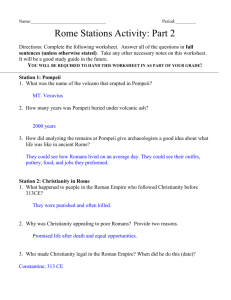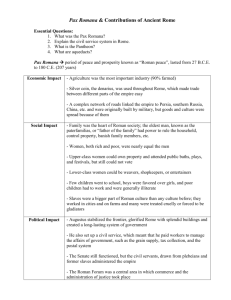Trajan*s Forum
advertisement

Trajan’s Forum Ali and Athena Forum and Layout A forum is a large public square; Trajan’s includes a market, basilica, temples, and libraries on the outskirts Built by Apollodorus of Damascus Last of the imperial fora Forum and Layout (cont.) Forums are the center of social and political life during these times News and important events are discussed here Contains vital governmental buildings About the Trajan Forum Paved with white marble and lined with stoa Large equestrian statue of Trajan in the middle On the northern side is the Basilica Ulpia, a judicial building, with a sqinch Has exedrae on lateral sides of the central piazza (square shaped open area) Trajan’s Market Next to forum on the Northeast side Made of concrete and brick (they’re fireproof!) 150+ shops and offices on multiple levels Groin vaulted main hall Floor levels added in middle ages; it was fortified for defensive purposes Pompeii and the House of the vettii Marx Zhan, John Stokes, Andrew Brennen History The oldest ruins in Pompeii date back to the 8th century BCE Pompeii was a major port city, thriving in trade Due to the eruption of Mount Vesuvius in 79 CE, it was lost for nearly 1700 years before being discovered in its nearly pristine state Many buildings and art pieces are very well preserved House of the vettii - history Built in the 2nd century BCE, then rebuilt in approximately 62 CE as part of a remodeling project. Frescoes and art were finished shortly after the remodeling was completed. Example of traditional Roman home design Owned by two wealthy merchant brothers, Aulus Vettius Restitutus and Aulus Vettius Conviva. HOUSE OF THE VETTII ARCHITECTURE AND ART Contained a large peristyle garden just after the entranceway and atrium Large amount of wealth meant it had lots of water, a pool was located in the atrium of the house Many frescoes lined the walls of the home tRaditional roman home FLOORPLAN House of the vettii floorplan Used to celebrate the initiation rites for the god Bacchus (60-50BCE) Pompeii - Villa of the mysteries The Pantheon Dominique Wilson, Emily Norton, Gabbi Thatcher In the aftermath of the Battle of Actium, Marcus Agrippa built and dedicated the original Pantheon during 27 BCE. Originally, the temple was meant to worship Olympian gods. (Pantheon literally meaning “all the gods”) The inscription across the front reads: “Marcus Agrippa son of Lucius, who was consul three times.” In 609, the Byzantine emperor Phocas gave the building to Pope Boniface IV, who converted it to a Christian church. Rebuilt twice after fires in 80 and 110 AD. History Plan of the Pantheon A series of transverse barrel vaults hidden within the twenty foot wall concentrates the weight of the dome on eight massive supports. The concrete was poured in sections of over a huge molds. The weight of the dome is relieved by a series of coffers- which also adds geometrical articulation to the hemisphere. These coffers may have once contained gilded bronze rosettes or stars suggesting the heavens. The Dome A large dome makes up the center of the Pantheon. The dome has a large hole in it to let light in. Despite this hole, when it rains, the concrete soaks up the extra water. When rain does manage to get in, it falls through and then drains off through conduits. Marble veneer (facing) and two tiers of richly colored architectural detail conceal the internal brick arches and concrete structure of the twenty feet thick walls. Originally, the façade of the porch was literally all viewers could see of the building. Since their approach was controlled by an enclosed courtyard, the actual circular shape of the Pantheon was concealed. Viewers were therefore surprised to pass through the rectilinear and restricted aisles of the portico and the huge main door to encounter the gaping space of the circular room. Original Pantheon Floor Plan Ambulatory Dome The Coliseum Monty Farish Maria Ortiz Alex Cravero Random Facts! Originally the Flavian Amphitheatre Elliptical amphitheater in the center of Rome Largest ever built by Roman Empire Built of concrete and stone Pretty, Pretty Floor Plan More Random Facts! Ruined because of earthquakes and stonerobbers. Construction started in 72 AD under the emperor Vespasian, finished in 80 AD under Titus Further modifications made during Domitian’s reign (81-96 AD) Area used to be a very populated village before it was destroyed by the great fire of Rome. Soooo Much Random Facts Capable of seating 50000 spectators People were seated according to rank. Used for gladiatorial battles and public spectacles such as mock sea battles, animal hunts, executions, re-enactments of famous battles, and dramas based on Classical mythology Later reused for housing, workshops, quarters for religious order, a fortress, a quarry, and a Christian shrine Ara Pacis and Pont-du-Gard Jake Tapia Joey Avioli Ara Pacis - Background Commissioned for the return of Augustus to Rome Located in the Northern Outskirts of Rome, Campus Martius Altar of Peace Ara Pacis - East & West Walls East Wall – female warrior sitting on weapons symbolizing peace. West Wall – Romulus and Remus were discovered by a farmer. Ara Pacis – North and South Wall South Wall – realistic figures, Augustus and Tiberius North Wall – modern figures. Consists of members of the imperial family. Shows some kind of Hellenistic Prince Pont-du-Gard Roman aqueduct located in France Built from 40 to 60 AD 160 feet high, 902 feet long (upper), 21 feet wide. Built of shelly limestone Pont-du-Gard Cranes and pulleys built the aqueduct Part of the Nimes aqueduct to carry water from a spring to Roman colony of Nimes Arch of Titus By: Laira Kelley, Kirby Fitzpatrick, and Sydney Toth Basic Information Created in 81 C.E. during the Flavian period Located in Rome Built by Domitian to commemorate his brother’s capture of Jerusalem in 70 C.E. Architecture Made of concrete and faced with marble 50 feet tall Engaged composite columns Originally a base for a bronze statue of the Emperor in a four horsed chariot says “The Entablature Senate and the Inscription Roman people to the deified Titus Vespasian Augustus, son of the deified Vespasian.” Relief on inside walls shows Titus’s soldiers carrying sacred treasures from Jerusalem through Rome. Inside the Arch Spoils from the Temple of Solomon Passageway on the inside of the arch Menorah, return into Rome Inside The arch Sacking of Jerusalem The Basilica of Constantine Or Aula Palatina Lydia Livas Wilson Ward History Built 320 AD In Trier, Germany Constantine “In this sign, you shall conquer” Edict of milan Middle ages Bishop of Trier World war II Burned in air raid of allied forces Rebuilt, but the inner decorations were not restored Currently a protestant church Apse NAVE AISLES N A R T H E X Architecture Long, high ceiling (220 feet long, 90 feet wide, 98 feet high) Brick, concrete Building elongation due to the window size Originally not a free standing structure-had smaller rooms attached Hollow floor heating system Engaged Columns Round arches Floor Plan Current Interior Bath of Caracalla Christina Pistilli Rachel Masterson Aubrey Walter The YMCA of RomeA-Calidarium (hot bath) B-Nymphaeum C-Great Hall D-Frigidarium (Swimming Pool) E-Courts G-Palaestra (gym for boxing) H-Lecture Halls I-Vestibules L-Dressing Rooms N-Steam Baths Q-Lounges S-Gymnasia T-Study Rooms V-Nymphaea Bath of Caracalla general information Location- Roman Italy Time- 212AD – 216 AD during the reign of emperor Caracalla Would have to install 2000 tons of material for 6 years to complete this History 211 CE septimius severus began the construction of the public baths on the south east side of Rome For recreational and educational uses Colored of colorful marble and mosaics Groin and barrel vault Had large bay windows for natural light They had low ground furnaces that warmed up baths Other facilities included exercise rooms, shops, dressing rooms, gardens, stadium, libraries, painting gallery, auditoriums, and huge water reservoir Art found inside Baths were a site for important sculpture like Farnese Bull and Farnese Hercules La Banditaccia Necropolises Of Cerveteri By Kemplin Kaley And Keagan Lee City of the Dead La Banditaccia, was laid out similar to a town Streets linked burial mounds and tombs Tomb chambers partly or completely excavated underground, some completely cut out of solid bedrock. All burial tombs had roofs, some with corbel vaulting In tombs such as these, equestrian painter depicted happy bright subjects showing a tangible world beyond the tomb Brightly colored scenes of everyday leisurely life ,decorated the tombs walls Though the Tomb of the Diver is from Terquinia, it depicts the frivolity of these paintings well Some tombs are carved out of the rock to mimic rooms and houses. The Tomb of Reliefs is fully furnished, even Couches jugs and even robes were carved and molded. Remains of the deceased were either cremated and placed in a funerary urn or placed into a Sarcophagus Sarcophagus from Certeveri, depicts a couple happily engaging the viewer. Despite the archaic smile this piece holds a very different feel compared to the Greek funerary steala Thanks for watching! Arch of Constantin e Valerie Sarge and Neelav Dutta The Arch “To the Emperor Constantine, from the Senate Inscription and the Roman people. Since through divine inspiration and great wisdom he has delivered the state from the tyrant and his party with his army and noble arms, [we] dedicate this arch decorated with triumphal insignia.” Commemorates the victory over Maxentius in 312 CE. Three arches; larger than the Arch of Titus nearby. Hadrianic Tondi tondi and other ‘triumphal insignia’ Hadrian The were derived from other monuments. For example, the tondi were recovered from a monument to Hadrian. The left tondi represents a boar hunt; the right represents a sacrifice to Apollo. Constantine had them re-carved to represent himself in Hadrian’s place. Reliefs: Marcus Aurelius Marcus panelsAurelius to the top left and right were The derived from a monument to a victory by Marcus Aurelius over the Germans. The statues above the columns are unrelated; those were derived from a monument by Trajan. Trajan inner walls contain reliefs showing The Trajan’s victory over the Dacians, and above the columns are large statues of prisoners also made under Trajan. Purpose reuse led to a partial transferal of This the old Roman virtues, comparing Constantine to earlier emperors.







